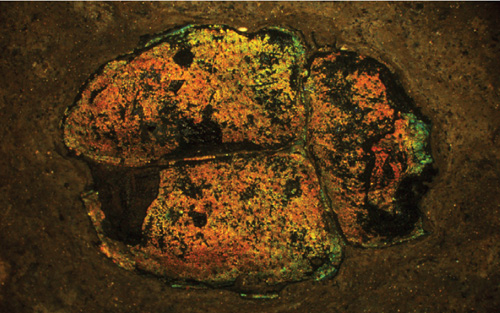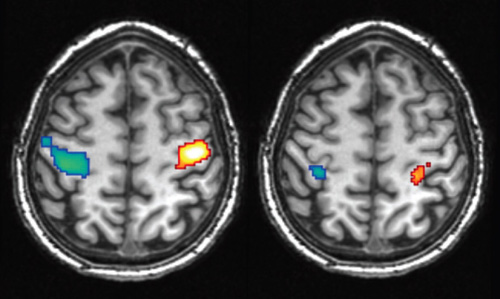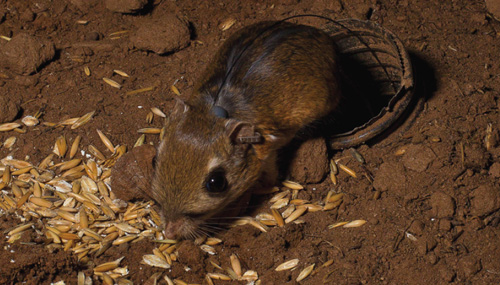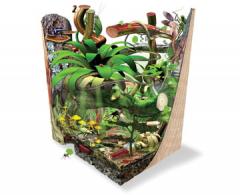
This Article From Issue
January-February 2012
Volume 100, Number 1
Page 27
DOI: 10.1511/2012.94.27
In this roundup, Elsa Youngsteadt summarizes notable recent items about scientific research, selected from news reports compiled in Sigma Xi’s free electronic newsletters.
Beetle Alchemy
This 47-million-year-old fossilized leaf beetle (Chrysomelidae) is as shiny today as it was in life. But the original insect was green, not gold. Nanoscale reflectors built into the surface of the insect’s body determine its color; the visible wavelengths depend on both the spacing of the reflectors and the extent to which they bend light. Electron microscopy revealed the reflective layers in several beetle fossils to be in perfect physical condition. But their chemical composition had changed. As a result, the fossils bend light differently than do living beetles, shifting their hues toward the red end of the spectrum. Knowing the ancient insects’ true colors could help researchers understand how they evolved their brilliant palette.

Photograph courtesy of Maria McNamara.
McNamara, M. E., et al. The original colours of fossil beetles. Proceedings of the Royal Society B (published online September 28)
A Molecule in Four-Wheel Drive
The first self-directed, single-molecule “car” has lurched its way across a few nanometers of a copper surface. Unlike earlier synthetic molecular gadgets, this one steers itself in an almost-straight line without being pushed or dragged. All it needs is a supply of electrons. The complex organic molecule consists of four lobes arranged around a central stem. Each lobe functions as a wheel, ratcheting the vehicle forward with alternating electronic excitation and relaxation. During the synthesis, only a fraction of the molecules end up with all four lobes attached so they rotate in the same direction—and even fewer land with their wheels touching the copper surface. But those that do show that chemists are getting ever better at engineering nanoscale devices.
Kudernac, T., et al. Electrically driven directional motion of a four-wheeled molecule on a metal surface. Nature 479:208–211 (November 10)
Dream Sequence
Neuroscientists have, for the first time, linked specific dreamed actions to localized brain activity. The unpredictability of dreams made this feat impossible in the past. But for this study, researchers recruited six young men who had learned to control their dreams. Each subject slept in the lab and tried, in his dreams, to clench his left hand, then his right. Two men completed the task, each in a different kind of brain scanner. The results showed that both dreamed and actual left-hand clenches activated the right sensorimotor cortex, and vice versa. But, as seen in the fMRI images below, the signals for waking actions (left) were much stronger than those for dreamed actions (right) . Although the sample size is tiny, the study takes one step toward uncovering the neurological basis of dreamed experience.

Image courtesy of the Max Planck Institute of Psychiatry.
Dresler, M., et al. Dreamed movement elicits activation in the sensorimotor cortex. Current Biology 21:1833–1837 (October 27)
Olives, Herbs and Juniper
Ancient Greek trade ships shuttled millions of amphoras—ceramic, vase-shaped storage jars—around the Mediterranean and Black seas. The containers are generally thought to have carried wine, but a new DNA analysis of nine jars, aged 2,200 to 2,400 years, suggests the freight was more diverse. Researchers swabbed and scraped DNA from the vessels and tested it for plant sequences. In five jars, they found grape DNA, consistent with wine. But they also found sequences from olive, juniper, turpentine tree, thyme and oregano, as well as from the walnut and ginger families. Every jar bore evidence of multiple species. The containers may have been reused with different cargo, or perhaps each one carried a mixture of ingredients preserved in herbs, oils and resins. If the DNA method proves reliable, analysis of shipwrecked containers could supplement historic accounts of ancient commerce and diet.
Foley, B. P., et al. Aspects of ancient Greek trade re-evaluated with amphora DNA evidence. Journal of Archaeological Science (published online October 7)
Bring the Neighbors!
A mean but familiar neighbor is better than a completely new one. At least that’s the case for endangered Stephens’ kangaroo rats (Dipodomys stephensi) . Efforts to move groups of the rodents to protected areas have failed, and biologists wondered whether neighbors would fare better together. It’s not that the kangaroo rats are social; rather, they’re solitary and fiercely territorial. But they do recognize their neighbors. In a new study, researchers relocated 99 animals—48 with familiar neighbors and 51 with strangers—and tracked their progress for one year. The rats who kept the same old rivals fought less, ate more and survived longer, yielding a total reproductive output 24 times greater than that of rats who had to sort out new relationships. Conservation efforts with other territorial animals may also need to take antisocial bonds into account.

Photograph courtesy of Ken Bohn, San Diego Zoo.
Shier, D. M., and R. R. Swaisgood. Fitness costs of neighborhood disruption in translocations of a solitary mammal. Conservation Biology (published online October 6)

American Scientist Comments and Discussion
To discuss our articles or comment on them, please share them and tag American Scientist on social media platforms. Here are links to our profiles on Twitter, Facebook, and LinkedIn.
If we re-share your post, we will moderate comments/discussion following our comments policy.